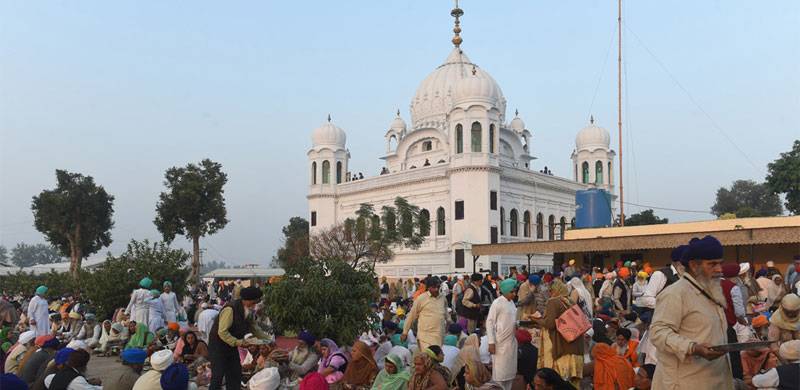
The much-awaited Kartarpur Corridor was inaugurated today. The border corridor connects two of Sikhism’s holiest places, Dera Baba Nanak in Indian Punjab and Gurdwara Darbar Sahib in Narowal. The 4.2-kilometres long passage is meant to facilitate Sikhs from India intending to visit the place where Baba Guru Nanak spent the last 18 years of his life.
It is said that Guru Nanak spent his life travelling through many places, spreading his message of universal peace and harmony wherever he went. The guru finally arrived in Kartarpur in 1521, when the Mughals were ruling India. The then-governor of the region, Duni Chand, donated around 100 acres to Guru Nanak on the bank of the river Ravi.
An article in theprint.in cited writer and former Indian diplomat Navtej Sharma as saying that, when the guru arrived in Kartarpur, he ‘shed his travelling garb’ and adopted the dress of a simple farmer.
After Guru Nanak's arrival, the place became a religious site. A prominent Indian poet and scientist, Puran Singh, said that the guru’s love and faith attracted people to him.
The community meal of the Sikhs, called guru ka langar, was also initiated in Kartarpur and became an essential part of the Sikh tradition.
When the guru passed away in 1539, it is said that his Hindu and Muslim devotees were in conflict over how the last rites of Guru Nanak should be performed; the Hindus wanted to burn him, while the Muslims wanted to bury him.
According to a myth, Guru Nanak asked both the Hindus and Muslims to put flowers over his body and wait through the night. In the morning, the guru had told them, they should observe the flowers and see which of those had remained fresh. Guru Nanak said that whichever community’s flowers were fresh would perform his last rites.
Legend has it that on the next morning, the body of Baba Guru Nanak had disappeared, with all the flowers being fresh. It was thus decided by both communities that they would divide the cloth that covered the guru’s body, with the Hindus burning it, and the Muslims buried it.
This resulted in two shrines being constructed to commemorate the final resting place of the revered figure in Kartarpur. Both the resting places are located in Gurdwara Kartarpur Sahib.
The shrines were later destroyed due to flooding, and were subsequently rebuilt. The foundation stone of the gurdwara Kartarpur was laid in 1572. Its dome was covered with gold by the ruler of the 19th century Sikh Empire in India, Maharaja Ranjeet Singh. The present structure was built in 1925 by the grandfather of Indian Punjab’s current chief minister, Captain Amrinder Singh.
It is said that Guru Nanak spent his life travelling through many places, spreading his message of universal peace and harmony wherever he went. The guru finally arrived in Kartarpur in 1521, when the Mughals were ruling India. The then-governor of the region, Duni Chand, donated around 100 acres to Guru Nanak on the bank of the river Ravi.
An article in theprint.in cited writer and former Indian diplomat Navtej Sharma as saying that, when the guru arrived in Kartarpur, he ‘shed his travelling garb’ and adopted the dress of a simple farmer.
After Guru Nanak's arrival, the place became a religious site. A prominent Indian poet and scientist, Puran Singh, said that the guru’s love and faith attracted people to him.
The community meal of the Sikhs, called guru ka langar, was also initiated in Kartarpur and became an essential part of the Sikh tradition.
When the guru passed away in 1539, it is said that his Hindu and Muslim devotees were in conflict over how the last rites of Guru Nanak should be performed; the Hindus wanted to burn him, while the Muslims wanted to bury him.
According to a myth, Guru Nanak asked both the Hindus and Muslims to put flowers over his body and wait through the night. In the morning, the guru had told them, they should observe the flowers and see which of those had remained fresh. Guru Nanak said that whichever community’s flowers were fresh would perform his last rites.
Legend has it that on the next morning, the body of Baba Guru Nanak had disappeared, with all the flowers being fresh. It was thus decided by both communities that they would divide the cloth that covered the guru’s body, with the Hindus burning it, and the Muslims buried it.
This resulted in two shrines being constructed to commemorate the final resting place of the revered figure in Kartarpur. Both the resting places are located in Gurdwara Kartarpur Sahib.
The shrines were later destroyed due to flooding, and were subsequently rebuilt. The foundation stone of the gurdwara Kartarpur was laid in 1572. Its dome was covered with gold by the ruler of the 19th century Sikh Empire in India, Maharaja Ranjeet Singh. The present structure was built in 1925 by the grandfather of Indian Punjab’s current chief minister, Captain Amrinder Singh.
